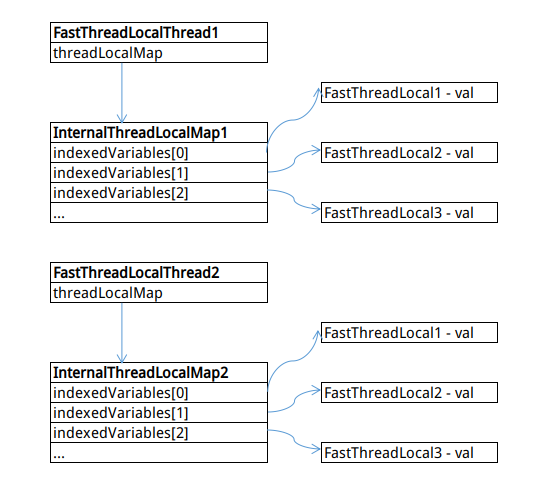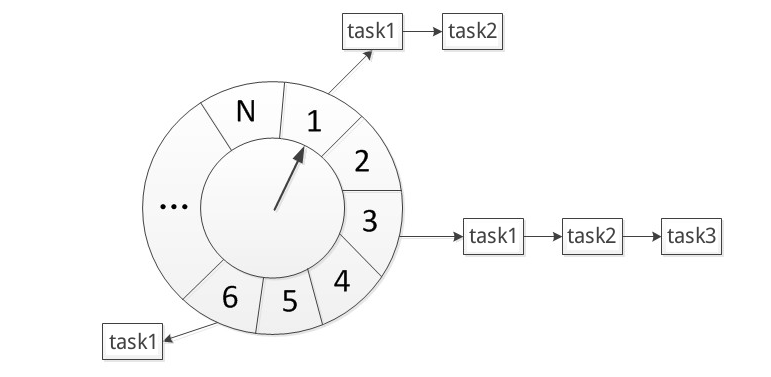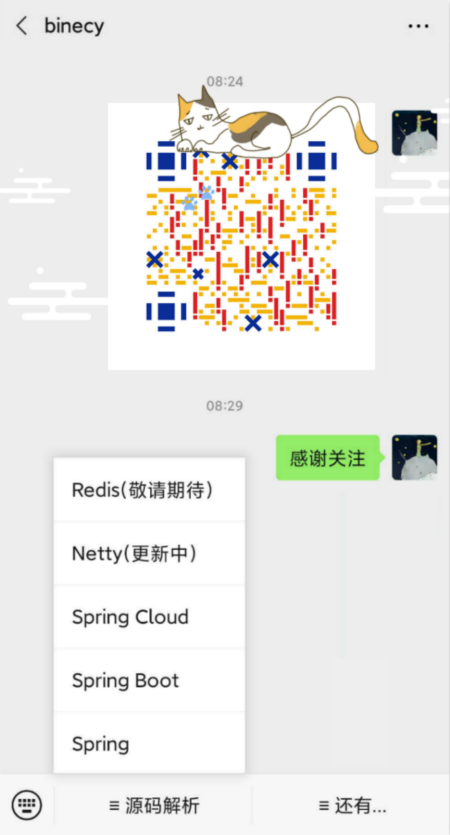Netty 源码解析 -- FastThreadLocal 与 HashedWheelTimer

Netty源码分析系列文章已接近尾声,本文再来分析Netty中两个常见组件:FastThreadLoca与HashedWheelTimer。
源码分析基于Netty 4.1.52
FastThreadLocal
FastThreadLocal比较简单。
FastThreadLocal和FastThreadLocalThread是配套使用的。
FastThreadLocalThread继承了Thread,FastThreadLocalThread#threadLocalMap 是一个InternalThreadLocalMap,该InternalThreadLocalMap对象只能用于当前线程。
InternalThreadLocalMap#indexedVariables是一个数组,存放了当前线程所有FastThreadLocal对应的值。
而每个FastThreadLocal都有一个index,用于定位InternalThreadLocalMap#indexedVariables。

FastThreadLocal#get
#1 获取该线程的InternalThreadLocalMap
如果是FastThreadLocalThread,直接获取FastThreadLocalThread#threadLocalMap。
否则,从UnpaddedInternalThreadLocalMap.slowThreadLocalMap获取该线程InternalThreadLocalMap。
注意,UnpaddedInternalThreadLocalMap.slowThreadLocalMap是一个ThreadLocal,这里实际回退到使用ThreadLocal了。
#2 每个FastThreadLocal都有一个index。
通过该index,获取InternalThreadLocalMap#indexedVariables中存放的值
#3 找不到值,通过initialize方法构建新对象。
可以看到,FastThreadLocal中连hash算法都不用,通过下标获取对应的值,复杂度为log(1),自然很快啦。
HashedWheelTimer
HashedWheelTimer是Netty提供的时间轮调度器。
时间轮是一种充分利用线程资源进行批量化任务调度的调度模型,能够高效的管理各种延时任务。
简单说,就是将延时任务存放到一个环形队列中,并通过执行线程定时执行该队列的任务。
例如,
环形队列上有60个格子,
执行线程每秒移动一个格子,则环形队列每轮可存放1分钟内的任务。
现在有两个定时任务
task1,32秒后执行
task2,2分25秒后执行
而执行线程当前位于第6格子
则task1放到32+6=38格,轮数为0
task2放到25+6=31个,轮数为2
执行线程将执行当前格子轮数为0的任务,并将其他任务轮数减1。

缺点,时间轮调度器的时间精度不高。
因为时间轮算法的精度取决于执行线程移动速度。
例如上面例子中执行线程每秒移动一个格子,则调度精度小于一秒的任务就无法准时调用。
HashedWheelTimer关键字段
添加延迟任务 HashedWheelTimer#newTimeout
#1 如果HashedWheelTimer未启动,则启动该HashedWheelTimer
HashedWheelTimer#start方法负责是启动workerThread线程
#2 startTime是HashedWheelTimer启动时间
deadline是相对HashedWheelTimer启动的延迟时间
构建HashedWheelTimeout,添加到HashedWheelTimer#timeouts
时间轮运行 Worker#run
#1 HashedWheelTimer#start方法阻塞HashedWheelTimer线程直到Worker启动完成,这里解除HashedWheelTimer线程阻塞。
#2 计算下一格子开始执行的时间,然后sleep到下次格子开始执行时间
#2 tick是从HashedWheelTimer启动后移动的总格子数,这里获取tick对应的格子索引。
由于Long类型足够大,这里并不考虑溢出问题。
#4 将HashedWheelTimer#timeouts的任务迁移到对应的格子中
#5 处理已到期任务
#6 移动到下一个格子
#7 这里是HashedWheelTimer#stop后的逻辑处理,取消任务,停止时间轮
迁移任务 Worker#transferTimeoutsToBuckets
#1 注意,每次只迁移100000个任务,以免阻塞线程
#2 任务延迟时间/每格时间数, 得到该任务需延迟的总格子移动数
#3 (总格子移动数 - 已移动格子数)/每轮格子数,得到轮数
#4 如果任务在timeouts队列放得太久导致已经过了执行时间,则使用当前tick, 也就是放到当前bucket,以便尽快执行该任务
#5 计算tick对应格子索引,放到对应的格子位置
执行到期任务 HashedWheelBucket#expireTimeouts
#1 选择轮数小于等于0的任务
#2 移除任务
#3 修改状态为过期,并执行任务
#4 其他任务轮数减1
ScheduledExecutorService使用堆(DelayedWorkQueue)维护任务,新增任务复杂度为O(logN)。
而 HashedWheelTimer 新增任务复杂度为O(1),所以在任务非常多时, HashedWheelTimer 可以表现出它的优势。
但是任务较少甚至没有任务时,HashedWheelTimer的执行线程都需要不断移动,也会造成性能消耗。
注意,HashedWheelTimer使用同一个线程调用和执行任务,如果某些任务执行时间过久,则影响后续定时任务执行。当然,我们也可以考虑在任务中另起线程执行逻辑。
另外,如果任务过多,也会导致任务长期滞留在HashedWheelTimer#timeouts中而不能及时执行。
如果您觉得本文不错,欢迎关注我的微信公众号,系列文章持续更新中。您的关注是我坚持的动力!

版权声明: 本文为 InfoQ 作者【binecy】的原创文章。
原文链接:【http://xie.infoq.cn/article/bc0eee467b70c49c6db12ca75】。文章转载请联系作者。












评论